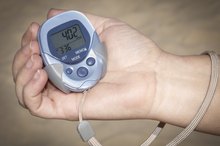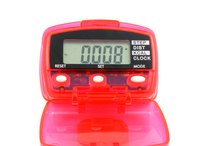How Many Calories Does 10,000 Steps Burn?
When you're trying to lose weight, walking 10,000 steps each day is a worthwhile goal because it burns a significant number of calories. That translates to a lighter body weight, less body fat and smaller hip and waist measurements, according to a study published in 2006 by the "American Journal of Health Promotions." It might sound like a lot of walking, but every step you take throughout your day counts toward your 10,000-step goal.
Average Caloric Burn
The specific number of calories you actually burn when walking depends on how briskly you walk and how much you weigh. However, the American Council on Exercise says that, on average, 10,000 steps equals about 5 miles, a distance in which you'll burn approximately 500 calories. If you take 10,000 steps every day, that translates to a total of approximately 3,500 calories burned in a week, the number of calories in 1 pound of fat.
Steps to Miles Conversion for a Pedometer
Learn More
Trying to keep track of your steps every day is next to impossible unless you clip on a pedometer to help you with the tally. Whether you're walking, running or going up and down the stairs, your pedometer senses the movement and makes note of it. You can get a basic model that does nothing more than display the number of steps you take, or you can opt for one with bells and whistles like timers, stop watches and distance and calorie calculators. Whichever model you favor, you should be able to find an accurate, quality pedometer in the affordable price range of $10 to $50.
- Trying to keep track of your steps every day is next to impossible unless you clip on a pedometer to help you with the tally.
Originally a Random Goal
10,000 steps each day is a legitimate goal to set, but it isn't one that started out based on health or fitness research. Harvard Health Publications reports that the goal originated in Japan in the mid-1960s when walking clubs became popular. Many people used a pedometer with the name Manpo-kei, which translates to "10,000 steps meter." Even though 10,000 isn't a number that was initially arrived at scientifically, it's since been proven to be a useful goal. Research -- such as a study done by the Department of Public Health Sciences at the University of Toronto -- on a daily 10,000-step goal concluded that during typical activity each day, most people take less than half of the goal number of steps. You need to deliberately take extra steps, adding activities like the stair-stepper or going for a walk in order to hit the 10,000 mark.
- 10,000 steps each day is a legitimate goal to set, but it isn't one that started out based on health or fitness research.
Choose Quality Over Quantity
Goal Setting Ideas to Improve Cardiorespiratory Endurance
Learn More
10,000 steps a day isn't a one-size-fits-all target. It might be too high a goal to set, especially if you are just starting out with a fitness regimen. It's OK to keep track of your steps on a pedometer, but use it first to determine how many steps you take during an ordinary day, then set your goal in small increments accordingly. For instance, you could aim to increase your steps by 1,000 per day for a couple of weeks or a month, then increase them by another 1,000 once you're routinely hitting that goal. Or ditch the pedometer altogether and make it a priority to walk briskly for 30 minutes a day at first, gradually building up the amount of time you spend walking. Shorter bouts of brisk walking that all add up to your goal time will benefit your heart and lungs as well as burn calories.
- 10,000 steps a day isn't a one-size-fits-all target.
- It might be too high a goal to set, especially if you are just starting out with a fitness regimen.
Related Articles
References
- Harvard Health Publications: Counting Every Step You Take
- American Council on Exercise: Calorie Burners: Activities That Turn Up the Heat
- Harvard Health Publications: Exercise Your Right to Health
- MayoClinic.com: Walking for Fitness? Make it Count With a Pedometer
- Clinical and Investigative Medicine: Daily Step Goal of 10,000 Steps: A Literature Review
- Tudor-locke C, Craig CL, Brown WJ, et al. How many steps/day are enough? For adults. Int J Behav Nutr Phys Act. 2011;8:79. doi:10.1186/1479-5868-8-79
- Lee IM, Shiroma EJ, Kamada M, Bassett DR, Matthews CE, Buring JE. Association of step volume and intensity with all-cause mortality in older women. JAMA Intern Med. 2019;179(8):1105-1112. doi:10.1001/jamainternmed.2019.0899
- Cai X, Qiu SH, Yin H, et al. Pedometer intervention and weight loss in overweight and obese adults with Type 2 diabetes: A meta-analysis. Diabet Med. 2016;33(8):1035-44. doi:10.1111/dme.13104
- Hasan H, Attlee A, Jan bin jan mohamed H, Aris N, Bin wan muda WAM. Counting footsteps with a pedometer to improve HMW adiponectin and metabolic syndrome among young female adults in the United Arab Emirates. J Obes. 2018;2018:1597840. doi:10.1155/2018/1597840
- Salin K, Hirvensalo M, Magnussen CG, et al. Changes in daily steps and body mass index and waist to height ratio during four year follow-up in adults: Cardiovascular Risk in Young Finns Study. Int J Environ Res Public Health. 2017;14(9). doi:10.3390/ijerph14091015
- Yuenyongchaiwat K. Effects of 10,000 steps a day on physical and mental health in overweight participants in a community setting: A preliminary study. Braz J Phys Ther. 2016;20(4):367-73. doi:10.1590/bjpt-rbf.2014.0160
Writer Bio
Elle Di Jensen has been a writer and editor since 1990. She began working in the fitness industry in 1987, and her experience includes editing and publishing a workout manual. She has an extended family of pets, including special needs animals. Jensen attended Idaho and Boise State Universities. Her work has appeared in various print and online publications.








